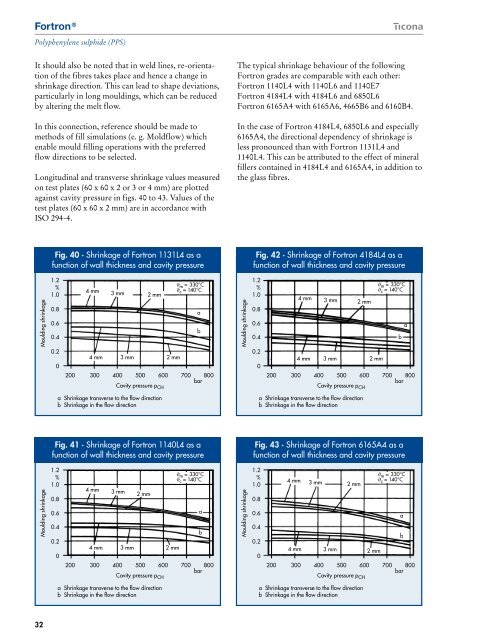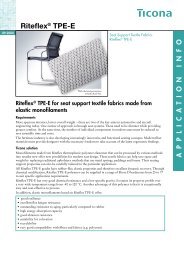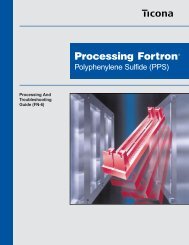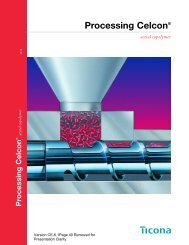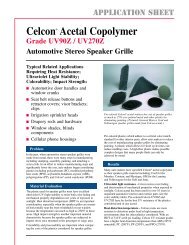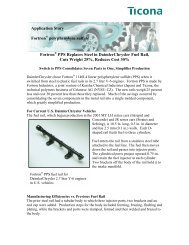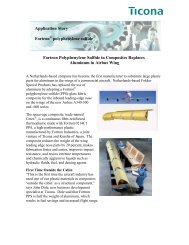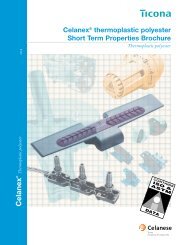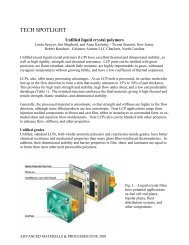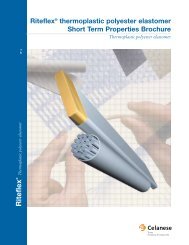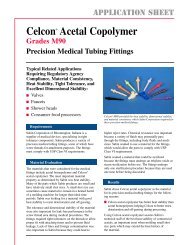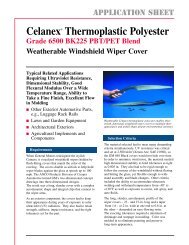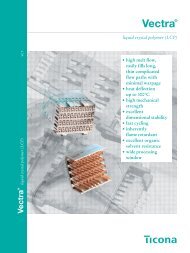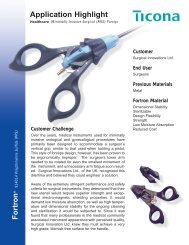Fortron PPS Product Brochure (B240) - Hi Polymers
Fortron PPS Product Brochure (B240) - Hi Polymers
Fortron PPS Product Brochure (B240) - Hi Polymers
You also want an ePaper? Increase the reach of your titles
YUMPU automatically turns print PDFs into web optimized ePapers that Google loves.
<strong>Fortron</strong> ®<br />
Polyphenylene sulphide (<strong>PPS</strong>)<br />
It should also be noted that in weld lines, re-orientation<br />
of the fibres takes place and hence a change in<br />
shrinkage direction. This can lead to shape deviations,<br />
particularly in long mouldings, which can be reduced<br />
by altering the melt flow.<br />
In this connection, reference should be made to<br />
methods of fill simulations (e. g. Moldflow) which<br />
enable mould filling operations with the preferred<br />
flow directions to be selected.<br />
Longitudinal and transverse shrinkage values measured<br />
on test plates (60 x 60 x 2 or 3 or 4 mm) are plotted<br />
against cavity pressure in figs. 40 to 43. Values of the<br />
test plates (60 x 60 x 2 mm) are in accordance with<br />
ISO 294-4.<br />
The typical shrinkage behaviour of the following<br />
<strong>Fortron</strong> grades are comparable with each other:<br />
<strong>Fortron</strong> 1140L4 with 1140L6 and 1140E7<br />
<strong>Fortron</strong> 4184L4 with 4184L6 and 6850L6<br />
<strong>Fortron</strong> 6165A4 with 6165A6, 4665B6 and 6160B4.<br />
In the case of <strong>Fortron</strong> 4184L4, 6850L6 and especially<br />
6165A4, the directional dependency of shrinkage is<br />
less pronounced than with <strong>Fortron</strong> 1131L4 and<br />
1140L4. This can be attributed to the effect of mineral<br />
fillers contained in 4184L4 and 6165A4, in addition to<br />
the glass fibres.<br />
Fig. 40 · Shrinkage of <strong>Fortron</strong> 1131L4 as a<br />
function of wall thickness and cavity pressure<br />
Fig. 42 · Shrinkage of <strong>Fortron</strong> 4184L4 as a<br />
function of wall thickness and cavity pressure<br />
Moulding shrinkage<br />
1.2<br />
%<br />
1.0<br />
0.8<br />
0.6<br />
0.4<br />
4 mm<br />
3 mm<br />
2 mm<br />
m = 330°C<br />
c = 140°C<br />
a<br />
b<br />
Moulding shrinkage<br />
1.2<br />
%<br />
1.0<br />
0.8<br />
0.6<br />
0.4<br />
4 mm<br />
3 mm<br />
2 mm<br />
m =330°C<br />
c = 140°C<br />
b<br />
a<br />
0.2<br />
0<br />
4 mm<br />
3 mm<br />
2 mm<br />
200 300 400 500 600 700 800<br />
bar<br />
Cavity pressure p CH<br />
0.2<br />
0<br />
4 mm<br />
3 mm<br />
2 mm<br />
200 300 400 500 600 700 800<br />
bar<br />
Cavity pressure p CH<br />
a Shrinkage transverse to the flow direction<br />
b Shrinkage in the flow direction<br />
a Shrinkage transverse to the flow direction<br />
b Shrinkage in the flow direction<br />
Fig. 41 · Shrinkage of <strong>Fortron</strong> 1140L4 as a<br />
function of wall thickness and cavity pressure<br />
Fig. 43 · Shrinkage of <strong>Fortron</strong> 6165A4 as a<br />
function of wall thickness and cavity pressure<br />
Moulding shrinkage<br />
1.2<br />
%<br />
1.0<br />
0.8<br />
0.6<br />
0.4<br />
0.2<br />
0<br />
4 mm<br />
4 mm<br />
3 mm<br />
3 mm<br />
2 mm<br />
2 mm<br />
m = 330°C<br />
c = 140°C<br />
200 300 400 500 600 700 800<br />
bar<br />
Cavity pressure p CH<br />
a<br />
b<br />
Moulding shrinkage<br />
1.2<br />
%<br />
1.0<br />
0.8<br />
0.6<br />
0.4<br />
0.2<br />
0<br />
4 mm<br />
4 mm<br />
3 mm<br />
3 mm<br />
2 mm<br />
2 mm<br />
m =330°C<br />
c = 140°C<br />
200 300 400 500 600 700 800<br />
bar<br />
Cavity pressure p CH<br />
a<br />
b<br />
a Shrinkage transverse to the flow direction<br />
b Shrinkage in the flow direction<br />
a Shrinkage transverse to the flow direction<br />
b Shrinkage in the flow direction<br />
32


